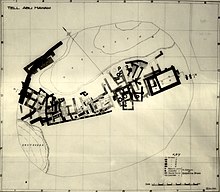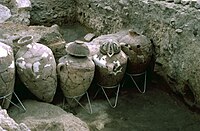Tell Abu Hawam


Tell Abu Hawam is the site of a small city established in the Late Bronze Age (circa 1600 BCE) in the area of modern-day Haifa, Israel.[1] The sixth century BCE geographer Scylax described the city[which?] as being located "between the bay and the promontory of Zeus", by the latter meaning the northwestern extremity of Mount Carmel. It existed as a port city and a fishing village, and was moved[when?] to the site south of what is now the neighborhood of Bat Galim. The city eventually expanded into what is now the city of Haifa.[dubious – discuss][citation needed]
The site was excavated by a British expedition from 1929 to 1933.[2]
Archaeology
[edit]During the 1929-1933 British excavations, a black-glazed bowl of the "fish-plate" type was uncovered, featuring a Phoenician graffito scratched on its underside. It is suggested that the bowl may originate from the 4th or 3rd century BCE.[2]

References
[edit]- ^ Balensi, Jacqueline (January 1985). "Revising Tell Abu Hawam". Bulletin of the American Schools of Oriental Research. 257: 65–74. doi:10.2307/1356819.
- ^ a b "Volume 5/Part 1 Galilaea and Northern Regions: 5876-6924", Volume 5/Part 1 Galilaea and Northern Regions: 5876-6924, De Gruyter, p. 692, 2023-03-20, doi:10.1515/9783110715774, ISBN 978-3-11-071577-4, retrieved 2024-02-05
- Encyclopedia Judaica, Haifa, Keter Publishing, Jerusalem, 1972, vol. 7, pp. 1134–1139
- The New Encyclopedia of Archaeological Excavations in the Holy Land, Volume 5, article Abu Hawam p 1553
